If you live in a country that observes daylight saving time, you’re likely familiar with the intense stares of hungry dogs, certain they’re starving, and willing you, with every ounce of their being, to feed them, stat!
As you prepare to “fall back” this season, the following tips can help smooth the transition for your animal friends:
- Don’t be so predictable. We humans often love routines, but it’s the predictability of our daily routines that leads our dogs to expect meals as a specific time. Rather than establish the pattern of feeding your dog at 6 a.m. and 5:30 p.m., whenever possible, establish a window of time within which your dogs will be fed, and randomize exact feeling times within that window. With this method, your dog learns to trust that meals consistently happen, but he’s less likely to become insistent as the clock approaches a specific time.
- Prepare for the time change. If changing your scheduled from a set feeding time to a meal window doesn’t work for your household, start preparing your dog for the time change a month or so in advance. Feed your dog 10 minutes later than usual for one week, then 20 minutes later than usual, then 30 minutes later, and so on, until the time changes and, suddenly, the one-hour time difference doesn’t feel like that big of a deal.
- Occupy your dog’s mind. Help your dog take his mind off the delayed meal by going on a light walk or doing some training in the hour between when his body tells him it’s mealtime and when the clock supports his request. Make sure your dog’s breathing has fully returned to normal before feeding to help prevent gastric dilatation and volvulus, also known as “bloat,” which is thought to be caused, in part, by gulping air during meals.
With a little preplanning, you and your dog can both enjoy a smoother transition away from daylight saving time and into standard time. Another tip: When the time change finds you out walking well after the sun has set, help keep yourself and your dog safe with high visibility gear.






